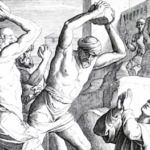We run our website the way we wished the whole internet worked: we provide high quality original content with no ads. We are funded solely by your direct support. Please consider supporting this project.

When the Law Demanded the Death Penalty
The Sinai covenant is significantly structured around violence. It motivates behavioral conformity by promising rewards and threatening violence. Without the threat of violence, the law looses its “teeth.” If the law is an acquiescence to sin, then the divinely sanctioned violence that is associated with it must also be considered an acquiescence to sin.
The conciliatory nature of the violence associated with the law is further confirmed, in my mind, by the fact that the violent dimension of this law parallels, in many respects, what we find among Israel’s ancient Near East neighbors. Among these cultures it was not uncommon to punish certain crimes by maiming people, stoning them, burning them alive or putting them to death in other ways. To be sure, Israel is highly unique in that its law is far more focused on religious and sexual crimes than what we find elsewhere. And as harsh as much of the law of the OT is, it is in many respects more humane, especially toward women and slaves, than what we find in other ancient law codes. Nevertheless, the basic violent mindset that permeates the law of the OT reflects the violent mindset of the ancient culture Israel was embedded in. And this, I argue, suggests that the portrait of God endorsing these laws is an accommodation to the culturally conditioned mindset of the Israelites.
The point is further confirmed when we consider how Jesus responded to the woman who was caught in the act of adultery, a crime that explicitly prescribes death by stoning (Lev 20:10-12). When asked what he felt should be done with the woman, Jesus ingeniously exposed the inherent immorality of the law by saying, “Let any one of you who is without sin be the first to throw a stone at her” (Jn 8:7). Jesus’ point is that, apart from the question of whether or not an adulterer (or any other sinner) deserves to die, only a sinless person would be justified in carrying it out.
In a sense, Jesus is going a step beyond Paul who argued that, while the law is holy in its own right, it functions as a curse by virtue of the fact that no one can live up to it. Jesus is here suggesting that, not only is there no one who is holy enough to live up to it; there is no one who is holy enough to carry it out. And the curse of the law applies as much to the first category of people as to the second. In any event, in light of this, we can hardly imagine Jesus commanding sinners in the OT to bring the curse of the law upon themselves by bringing the death-penalty curse of the law upon others. And since Jesus reveals God’s true character and will, we shouldn’t imagine that it was God who was actually commanding his people to put others to death.
What we can imagine God doing, and what I believe we should imagine God doing, is acting like a missionary. As a heavenly missionary to a depraved and oppressed world, God patiently works with people in the sinful condition he finds them. The incarnational and sin-bearing God thus stooped to work within the fallen, culturally conditioned framework of his people, thereby wearing their distorted, Rorschach-like perceptions of him.
Given what we now know about God in Christ, we must assume it grieved God’s heart to allow—and even appear to command—people to be maimed, stoned to death or even burned alive for committing certain crimes. Yet, because God refuses to lobotomize people to conform them to his ideal, he had no choice but to patiently accommodate and bear their sin by taking on the semblance of a God who approves of such violence.
Image by tamaki via Flickr.
Category: General
Tags: Cruciform Theology, Law, Old Testament, Religious Violence, Violence
Related Reading

One Hope
When Jesus was crucified by his enemies instead of conquering his enemies, the hope of Jesus’ disciples came crashing down in utter despair. They had hoped that Jesus would establish the kingdom of God in the same way that other kingdoms were established. However, the resurrection reveals that the kingdom of God is not like…

Friday Lights: The Bee
Ever heard of The Babylon Bee? It’s a satirical site, sort of like The Onion for Christians. Several of our readers pointed out this site to us, and we loved this entry on an adult coloring book of the imprecatory psalms. It forces you to think through the ways we uncritically accept the violence of some…

Did God use Satan to test Job?
Question: In Job 1:21 and 2:10, Job seems to accept “adversity” from God while continuing to trust him. Job blames his troubles on God (i.e. “He shattered me” [16:12], “He breaks me down on every side” [19:10], “For he performs what is appointed for me” [23:14]). In Chapters 1 and 2, God even seems to…

Podcast: Is Accepting Evolution with All It’s Violence Compatible with Believing in a Loving Creator?
Greg considers the violence inherent in evolution (and in nature itself) in light of our belief in an all-loving creator. http://traffic.libsyn.com/askgregboyd/Episode_0169.mp3

Sermon 7/22/12: The Shadow of the Cross
In his sermon this past Sunday, Greg continued his fleshing out thoughts from the previous week on how he reconciles the violent, disturbing portraits of God in the Old Testament with the revelation of God in Jesus Christ on the Cross. He answers a question raised by several in response to last week’s sermon: Did God actually engage…

Podcast: What is Crucifixion of the Warrior God?
In this 100th episode Greg gives us a peek at Crucifixion of the Warrior God. Pre-order your copy of the book here: The Crucifixion of the Warrior God: Volumes 1 & 2 (Fortress Press, 2017) http://traffic.libsyn.com/askgregboyd/Episode_0100.mp3
